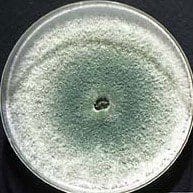STRUCTURE AND PHYSIOLOGY
Trichoderma viride, also known as green mold, is primarily found in rotting wood, soil, and plants’ root systems and tolerates temperatures between 15°C and 40°C (59°F – 104°F). It acts primarily as an opportunistic, non-virulent, symbiotic fungus in most plant species and is often used for the biological control of bacterial and fungal plant pathogens. It demonstrates saprophytic and parasitic behavior on other fungi.
TRANSMISSION AND DISEASE
Trichoderma species can cause opportunistic fungal infections in those with compromised immunity as fungal spores are common in the air, especially in moldy interiors. Under certain conditions, Trichoderma viride produces gliotoxin, a mycotoxin that can be neurotoxic and serves as immunosuppression.
UNIQUE OR INTERESTING FACT
This fungus is primarily used in agriculture to inhibit the growth of plant pathogens and encourage plant growth.
REFERENCES
Ward, J. “Trichoderma viride – Morphology, Benefits & Health Risks.” Mold Busters (2022). Available at: https://library.bustmold.com/trichoderma/trichoderma-viride/?msclkid=5b491d34d06711eca9d03e7bc4bb1206. (Accessed: 10th May 2022)
Nagwa E. Awad, Hanaa A. Kassem, Manal A. Hamed, Amal M. ElFeky, Mohamed A. A. Elnaggar, Khaled Mahmoud & Mohamed A. Ali (2018) Isolation and characterization of the bioactive metabolites from the soil derived fungus Trichodermaviride, Mycology, 9:1, 70-80, DOI: 10.1080/21501203.2017.1423126
Image from: https://biocontrol.entomology.cornell.edu/pathogens/trichoderma.php

